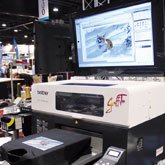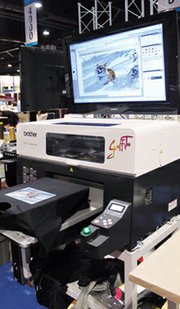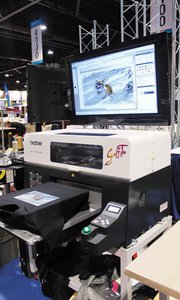Advances Bring Digital Printing to the Forefront
Until about two years ago, American Apparel didn’t do much printing, and when it did, the vertical manufacturer used outside vendors.
But when the company began introducing more printed hoodies, dresses, baby clothes and T-shirts, including its “Legalize” collection (T-shirts featuring logos such as “Legalize LA” and “Legalize Gay”), its printing needs—and equipment—expanded.
Today, the Los Angeles–based company uses both screen printing and Brother International’s GT541 and GT782 digital inkjet printers.
“We recognize the future with digital inks and digital technology, and we also appreciate and use screen-printing technology,” said Robert Lopez, American Apparel’s print-studio manager. “Depending on the cost of the ink and the job, we’ll use [screen printing] for large runs if it’s cost effective, but we like the soft hand of digital printing. American Apparel does very soft fabric, and that’s what it’s known for, and we want the prints to reflect the brand of the company.”
The debate over screen printing versus direct to garment is still ongoing, but advances in digital inkjet printing appear to be closing the gap between the two.
Brother’s digital inkjet printers are making waves in the apparel industry with their ability to print on 100 percent cotton. The printers have proven especially popular with California buyers, who often use them for printing on T-shirts, according to Matthew Rhome, an accounts manager for Brother.
California is the company’s largest market for the printers, and with all of its T-shirt and apparel manufacturers, the city of Los Angeles is almost No. 1 nationally, ranking right behind the state of Florida, he said.
Brother launched its first digital inkjet garment printer in 2005, which could only print on light-colored fabrics, followed by a second digital printer two years ago, which could also print on dark fabrics. While the company is not allowed to release detailed numbers, it has more than 3,000 of these units currently in the field, Rhome said.
Its new GraffiTee series, which debuted in October and replaces the earlier GT541 and GT782 models, is a smaller, cheaper digital inkjet printer, which retails for $22,000, compared with $55,000 for the previous models.
Rhome showcased the new series at the Texprocess trade show in Atlanta in April and said he was “swamped” with interested buyers.
“I’ve never been to a trade show with such a good response,” he said. “Compared to any show I’ve done in five years, that one was the best.”
The digital printer can print on both 100 percent polyester and 100 percent cotton, with a special water-based ink formulated for cotton printing. Another bonus is that it can also print on dark-colored cotton fabrics, Rhome explained.
“It’s big time; it really is. It has really changed a lot of things—from the small guy who wants to start a business in his garage all the way to large international companies that are buying this machine for multiple reasons,” he said.
Smaller companies are using the digital printers as a replacement for traditional screen printing, and larger companies use them as a sampling device in their art department to brainstorm without having to spend the time or money to set up the screens or films one would need with screen printing, he said.
The digital inkjet printers also print detail at a much higher quality, printing at roughly 1200 dpi, compared with about 70 dpi for screen printing, which works well for printing photographs or detailed art, he explained.
Print versus screen
However, screen printing still remains cheaper for large runs, and ink for screen printing tends to be about 70 percent less expensive than Brother’s ink for digital printing, Rhome noted. Another drawback is that currently, with polyester, digital printers can only print on light-colored fabrics, as opposed to both light and dark fabrics with cotton.
Some screen printers question the durability and longevity of digital prints.
“I’ve been in business for more than 30 years, and direct to garment is not perfected as of yet,” said Dave Pohar, owner of New Way Silk Screen Printing in Los Angeles. “It’s only good for about 50 washes. … If you wash it, it will wash out.”
Pohar’s company prints T-shirts, sweatshirts, shorts and pants using a four-color direct silk-screening process.
“Direct screen printing will stay in unless you use schlock ink,” he said.
Rhome noted that Brother is the only company in the market that both manufactures its own print heads and formulates its own inks, and because they’re a matched pair, they provide good printing results that last. They also use pigment, which he says provides more durability and less fading than dyes.
“We test with an AATCC [American Association of Textile Chemists and Colorists] test that we use as a benchmark for testing, and we come in about the same as water-based screen-printing inks in terms of quality and durability,” he said.
American Apparel’s Lopez maintains that screen prints can be slightly more durable than digital but disputes that digital printing will wear off prematurely.
“That means it wasn’t cured right,” he said. “Here, we have quality control that just does quality control, and curing is done by the operators. The last person checks the color and design and colorfastness.”
Printing on some of the looser weave fabrics in the market could cause a digitally printed image to fade, but American Apparel produces shirts known for their tight weave and ability to hold color, Lopez said.
One advantage to screen printing is that it can provide richer, brighter hues for particular colors, Lopez said.
“For matching Pantone colors, you can’t beat it,” he said. “With screen printing, you can get brighter colors because you can mix colors by hand, but there’s only so much control you have with digital inks because they’re CMYK—they just use yellow, cyan, magenta and black to mix colors. … As far as using a primary color, like red or blue, you can’t do that with digital—only with silk screening.”
American Apparel also uses digital printing for photographic prints or more intricate art because of the detailed, high-quality prints, as well as using it for sampling in-house designs.
“It’s a fast way to get an image—designers come up with something new and put it on a garment before we decide whether to kill it. We can produce a sample within the hour and decide if we’re going to make it or not,” Lopez said. “As far as sampling, you can’t beat it.”
It’s something the company is looking forward to experimenting more with, he said.
“Digital can go a lot further,” he said. “It’s just scratching the surface.”
























